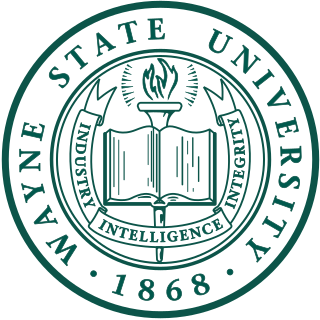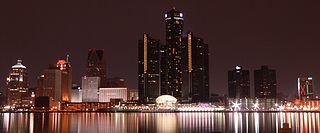
Detroit is the most populous city in the U.S. state of Michigan. It is the largest U.S. city on the United States–Canada border, and the seat of government of Wayne County. Detroit had a population of 639,111 at the 2020 census, making it the 29th-most populous city in the United States. The Metro Detroit area, home to 4.3 million people, is the second-largest in the Midwest after the Chicago metropolitan area and the 14th-largest in the United States. A significant cultural center, Detroit is known for its contributions to music, art, architecture and design, in addition to its historical automotive background.

Michigan is a state in the Great Lakes region of the Upper Midwest region of the United States. It borders Wisconsin to the northwest in the Upper Peninsula, and Indiana and Ohio to the south in the Lower Peninsula; it is also connected by Lakes Superior, Michigan, Huron, and Erie to Minnesota and Illinois, and the Canadian province of Ontario. With a population of nearly 10.12 million and an area of 96,716 sq mi (250,490 km2), Michigan is the 10th-largest state by population, the 11th-largest by area, and the largest by area east of the Mississippi River. Its capital is Lansing, and its largest city is Detroit. Metro Detroit is among the nation's most populous and largest metropolitan economies. The name derives from a gallicized variant of the original Ojibwe word ᒥᓯᑲᒥ, meaning "large water" or "large lake".

Wayne State University is a public research university in Detroit, Michigan. It is Michigan's third-largest university. Founded in 1868, Wayne State consists of 13 schools and colleges offering approximately 350 programs to nearly 24,000 graduate and undergraduate students. Wayne State University, along with the University of Michigan and Michigan State University, compose the University Research Corridor of Michigan. Wayne State is classified among "R1: Doctoral Universities – Very high research activity".

Metro Detroit is a major metropolitan area in the U.S. state of Michigan, consisting of the city of Detroit and over 200 municipalities in the surrounding area with its largest employer being Oakland County. There are varied definitions of the area, including the official statistical areas designated by the Office of Management and Budget, a federal agency of the United States.

The Chicago Hub Network is a collection of proposed fast conventional and high-speed rail lines in the Midwestern United States including 3,000 miles (5,000 km) of track. Since the 1990s, there have been multiple proposals to build a network from Chicago to destinations such as Milwaukee, Madison, Minneapolis, Indianapolis, Detroit, Kansas City, St. Louis, Cleveland, Cincinnati, and Louisville. In addition, the rail lines from the Chicago hub would connect through to cities in Canada. Eastern routes from Chicago would also blend into the Ohio Hub network. In addition to providing better connections between Midwestern cities, the projects are intended to reduce or eliminate the operating subsidies that American passenger train routes currently require.

The economy of New York City encompasses the largest municipal and regional economy in the United States. In 2022, the New York metropolitan area generated a gross metropolitan product (GMP) of US$1.4trillion, with a population of 23.6 million people. Anchored by Wall Street in Lower Manhattan, New York City has been characterized as the world's premier financial center. The city is home to the New York Stock Exchange and Nasdaq, the world's two largest stock exchanges by both market capitalization and trading activity.

Central Michigan, also called Mid Michigan, is a region in the Lower Peninsula of the U.S. state of Michigan. As its name implies, it is the middle area of the Lower Peninsula. Lower Michigan is said to resemble a mitten, and Mid Michigan corresponds roughly to the thumb and palm, stretching from Michigan's eastern shoreline along Lake Huron into the fertile rolling plains of the Michigan Basin. The region contains cities of moderate size, including Flint, Saginaw, and the state capital of Lansing. Generally Central, or "Mid", Michigan is defined by governmental organizations as an area North of Jackson, and South of Clare.
Life Sciences Greenhouse of Central Pennsylvania (LSGPA) is a biotechnology initiative and non-profit organization based in Harrisburg, Pennsylvania. It was founded in 2001. It focuses on in the advancement of life sciences through technology to improve the healthcare and economic opportunities of Pennsylvanians.

The metropolitan area surrounding and including Detroit, Michigan, is a ten-county area with a population of over 5.9 million, a workforce of 2.6 million, and about 347,000 businesses. Detroit's six-county Metropolitan Statistical Area has a population of about 4.3 million, a workforce of about 2.1 million, and a gross metropolitan product of $200.9 billion. Detroit's urban area has a population of 3.9 million. A 2005 PricewaterhouseCoopers study estimated that Detroit's urban area had a gross domestic product of $203 billion.
Planning and development in Detroit since the late 20th century has attempted to enhance the economy and quality of life of Detroit, Michigan, United States. In 1970, the private group Detroit Renaissance began to facilitate development in the city. Its successor, Business Leaders for Michigan, has continued to facilitate development into the 21st century. Projects have included new commercial facilities, revitalization of neighborhoods, hospitality infrastructure, and improvements to recreational and public facilities, such as the QLine light rail project.

Pittsburgh Life Sciences Greenhouse (PLSG) is an investment firm based in the South Side neighborhood of Pittsburgh, Pennsylvania that provides resources and tools to entrepreneurial life sciences enterprises in Pittsburgh and western Pennsylvania in order to advance research and patient care.

The Golden LEAF Foundation is a nonprofit corporation based in Rocky Mount, North Carolina in the United States, that was created in 1999 to receive half of the funds coming to North Carolina from the master settlement agreement with cigarette manufacturers. The foundation is now devoted to advancing the economic well being of North Carolinians and to transforming its economy. It works in partnership with local governments, educational institutions, economic development organizations and other public agencies, and nonprofits to achieve this goal.

Bio-1 is a consortium of partners founded in 2007 designed to identify and promote bioscience in the Central New Jersey area. It is the result of a $5 million grant made available by the Workforce Innovation in Regional Economic Development (WIRED) program.

The University Research Corridor (URC) is an alliance between Michigan State University, the University of Michigan, and Wayne State University to transform, strengthen, and diversify the state of Michigan's economy. The three institutions of the URC together draw $1.878 billion in federal academic research dollars to Michigan, 94 percent of the total coming into the state.
China has seen double-digit growth in its biotechnology industry and has gone from being one of the slowest to one of the fastest nations in the adoption of new biotechnologies. The biotech sector is seen in China and internationally as a core area of national scientific and economic development. The main national biotech body in the country is the China National Center for Biotechnology Development. The CNCBD is an organization established on November 3, 1983, under the Ministry of Science and Technology with the approval of the State Council. CNCBD is the sole national center to coordinate and implement the national S&T program in Biotechnology and Health.

The Ohio bioscience sector strength was ranked #4 among USA states in 2008 by Business Facilities magazine.

Neogen Corporation is an international food safety company that provides test kits and relevant products to detect dangerous substances in food. The company was founded in 1982 and is based in Lansing, Michigan. The company serves a wide range of countries including Canada, United States, the United Kingdom, parts of Europe, Mexico and Brazil, India, and China, among others. As of 2016, the company has a market capitalization of $1.83 billion with an enterprise value of $1.57 billion. The company operates a product line of over 100 drug detection test kits worldwide for the detection of about 300 abused and therapeutic drugs in animal treatment. In 2009, it became a vendor of the Chinese government and has been engaged in researching China-specific food safety and plant health issues.

Henri A. Termeer was a Dutch biotechnology executive and entrepreneur who is considered a pioneer in corporate strategy in the biotechnology industry for his tenure as CEO at Genzyme. Termeer created a business model adopted by many others in the biotech industry by garnering steep prices— mainly from insurers and government payers— for therapies for rare genetic disorders known as orphan diseases that mainly affect children. Genzyme uses biological processes to manufacture drugs that are not easily copied by generic-drug makers. The drugs are also protected by orphan drug acts in various countries which provides extensive protection from competition and ensures coverage by publicly funded insurers. As CEO of Genzyme from 1981 to 2011, he developed corporate strategies for growth including optimizing institutional embeddedness nurturing vast networks of influential groups and clusters: doctors, private equity, patient-groups, insurance, healthcare umbrella organizations, state and local government, and alumni. Termeer was "connected to 311 board members in 17 different organizations across 20 different industries" He has the legacy of being the "longest-serving CEO in the biotechnology industry.

Greater Boston, primarily Boston and Cambridge, is home to more than 1,000 biotechnology companies, ranging from small start-ups to billion-dollar pharmaceutical companies. The many universities in the area give the region a large network of scientists.


















